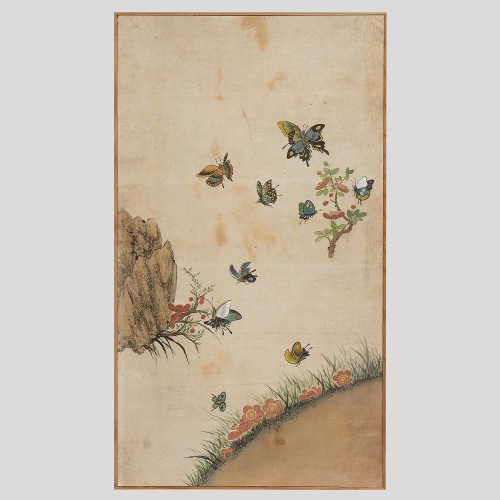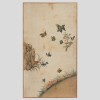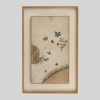본문
꽃과 나비를 함께 그린 그림을 호접도(胡蝶圖)라고 부릅니다. 다른 명칭으로는 화접도(花蝶圖), 군접도(群蝶圖), 백접도(百蝶圖) 등이 있습니다.
화려하게 피어난 꽃들 사이를 자유롭게 날아다니는 나비는 따뜻한 계절의 시작을 직관적으로 전합니다.
전통 회화에서 나비는 기쁨과 자유, 꽃은 생명력과 아름다움을 뜻해 두 요소가 만나면 부부의 화목과 사랑을 암시합니다. 또한 나비를 뜻하는 '접(蝶)'의 음이 중국어로 여든 노인을 뜻하는 ‘질(耋)’의 음과 같아 장수의 상징으로도 여겨집니다.
이 그림 속에는 열 마리의 나비가 등장하는데 각기 다른 방향으로 흩날리듯 그려져 생동감이 느껴집니다. 꽃은 화면 우측 하단, 좌측 중앙, 우측 중앙에 분산 배치되어 시선의 흐름에 변화를 주며 나비와 조화를 이룹니다. 다채로운 구도로 그려진 꽃과 나비는 자연에 대한 찬미이자 인간의 소망을 담은 시각적 표현이라 할 수 있습니다.
호접도는 단순한 자연 묘사에 그치지 않고, 삶의 풍요와 감정의 교감을 전하는 예술로서 사랑받아 왔습니다.
━━━━━
描绘花与蝴蝶同在的图画,被称为胡蝶图,亦有“花蝶图”、“群蝶图”、“百蝶图”等别称。
在绚烂盛开的花丛中,自由飞舞的蝴蝶,直观地传达出温暖季节的到来。
在传统绘画中,蝴蝶象征喜悦与自由,花朵则寓意生命力与美丽,二者相结合,常被用来象征夫妻间的和睦与爱情。此外,“蝶”与“耋”(八十岁以上的老人)同音,因此蝴蝶也被视为长寿的象征。
此画中描绘了十只蝴蝶,它们姿态各异、朝不同方向飞舞,营造出生动灵动的画面感。花朵分布于画面的右下方、左侧中央及右侧中央,不仅与蝴蝶构成视觉上的和谐,也赋予画面丰富的节奏与层次变化。
如此多样的构图展现出对自然的赞美,同时也传达了人们对美好生活与情感的向往。
胡蝶图不仅仅是对自然的写实再现,更作为传达富足人生与情感共鸣的艺术形式,长期受到人们的喜爱与珍视。
━━━━━
A Hojeopdo(a painting of butterflies and flowers) is a painting that depicts flowers and butterflies together. It is also known as Hwajeopdo (Flower-Butterfly Painting), Gunjeopdo (Swarm of Butterflies), or Baekjeopdo (Hundred Butterflies).
Butterflies fluttering freely among blooming flowers visually announce the beginning of a warm season.
In traditional painting, butterflies symbolize joy and freedom, while flowers represent vitality and beauty. Together, they suggest conjugal harmony and love. Additionally, the Chinese pronunciation of “die” (蝶, butterfly) is a homophone for “die” (耋), meaning an octogenarian, making butterflies also symbols of longevity.
In this painting, ten butterflies are depicted in dynamic motion, flying in different directions. Flowers are dispersed throughout the right lower, left center, and right center of the composition, guiding the viewer’s gaze and harmonizing with the butterflies. This varied composition of flowers and butterflies is a visual expression of nature’s beauty and human aspirations.
The Hojeopdo transcends simple natural depiction, expressing emotional resonance and prosperity in life, and has long been cherished as a beloved form of traditional art. This painting, which captures the sentiment of spring through visual symbolism, represents the essence of naturalism in Korean traditional painting.


